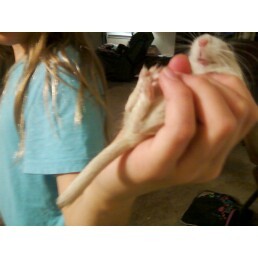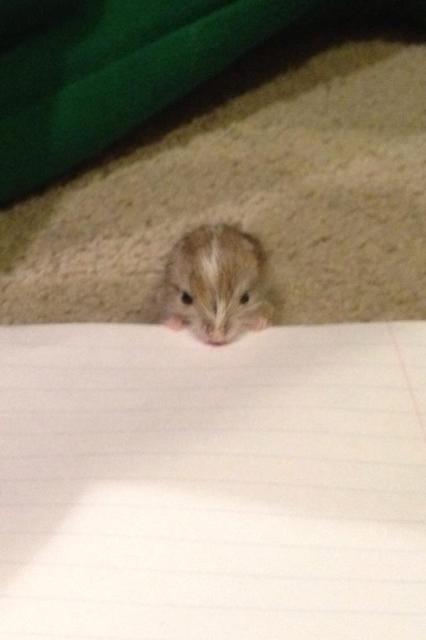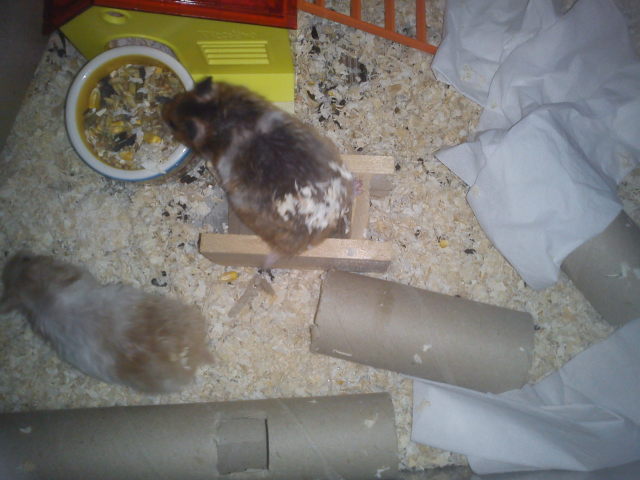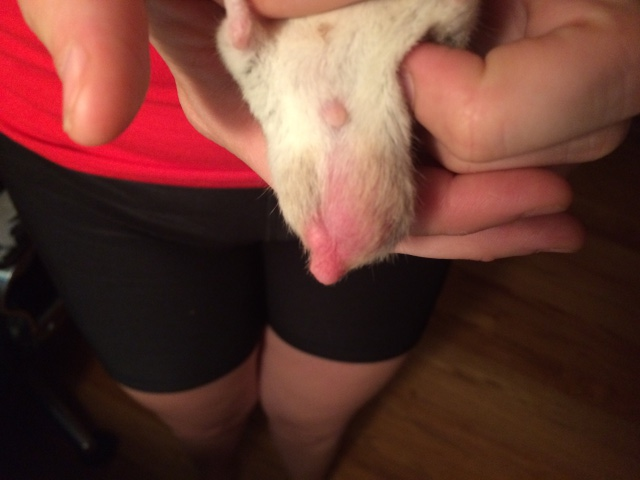QuestionQUESTION: Hi,
I've got a 2 year old Russian - a Campbell, I think - who I 'adopted' a few weeks ago from a family with young children. They hadn't held him in a while, and he was in one of those plastic cages with curling tunnels, and had no toys or wheel.
When I initially got him he was pleasant, and could be held without fuss. I've had Russians before and he seemed just as docile as they were.
Then, within the last few days, he has been up at all hours, madly scrabbling, chewing and climbing. He hangs at the front of the cage as long he can, consistently, trying to get out. He has plenty of toys, but he only cares about chewing them. He takes no notice of the food I give him, but when I go to take him out he bites me, hard, and hangs on.
I can't hold him any more, and he seems to hate his wire hamster cage.
Is something wrong?
Thanks,
ANSWER: Dear Becky,
thank you for your question. I apologize for taking so long to answer, AllExperts wasn't working for me for a while.
I think it's possible that the hamster starts behaving like a hamster now that he has the room for it. Dwarf hamster will often bite inside their cage, although many stop doing that once they have gotten used to their new home or when they get a bigger cage (how big is the cage you have him in now?). It's also possible that he has been hurt or at least stressed by the kids in his former family and he would remember that. In that case, you can try to just put your hand in the cage without actually touching him unless he comes to you. You can put a piece of an old t-shirt into the cage or some of your hair so that he gets used to your scent.
Chewing the toys and furniture is pretty normal for hamster. Offer him deep bedding so that he can dig as well, even though he may not do that at first. If you can, allow him time outside the cage, the best thing would be if he could go from his cage into some sort of playpen by himself. Most hamsters really love that and will enjoy it they will also be more relaxed when they can run outside their cage.
I hope I was of some help to you
Jennifer
---------- FOLLOW-UP ----------
QUESTION: Hi Jennifer,
thanks for the answer.
He has calmed down a bit now, he's in - it's called a Mickey Max cage?? He was easier to hold after I let him run around on the top of the sofa, and on the stairs. He still nips occasionally, but he doesn't cling on.
They gave him to us because they thought he was going to die soon, and didn't want the young children being upset. He's a year and six months old, and seems to be fine - I'm not sure what to look for in a hamster that's going to die? Is there some kind of indication - do they start calming down rapidly?
Thank you,
Becky.
AnswerI'm glad to hear that the hamster has calmed down a bit. It seems he needed some time to get used to all the new stuff. If you have the room for it, I would recommend a bigger cage, though. Hamsters really love to run and dig and from my experience a cage that's at least 100x50 cm long and wide (40x20") works best for them. A tank works well, too, and has the additional advantage that you can fill in the bedding really high without anything falling out when the hamster digs his tunnels.
Some hamsters will loose weight when they grow old, some will get a hump, like this:
http://i147.photobucket.com/albums/r294/jedediah667/maeuse/Bild010.jpg (that's one of my fancy mice who was 2.5 years at the time, she died soon after that)
Sometimes the fur will get thinner and the hamster will move more slowly and sleep more. But there's no sure sign that tells you that the hamster will die, I've had rodents that looked frail, with thin fur and slow movements (perfectly healthy, though) that still lived for six months or more.
1.5 years is middle aged for a healthy dwarf hamster. Unless he gets sick, he should be around for at least six months, maybe a year longer. Have fun with him :)

 Help my gerbil!
QuestionMy gerbils tail
QUESTION: Hello,
Help my gerbil!
QuestionMy gerbils tail
QUESTION: Hello,
 orphaned gerbil =(
QuestionQUESTION: Hi Sheila,
My daughters English class
orphaned gerbil =(
QuestionQUESTION: Hi Sheila,
My daughters English class
 hamster fight
Question
hamsters
i already have 2 syrian hamsters (bot
hamster fight
Question
hamsters
i already have 2 syrian hamsters (bot
 Syrian Hamster - Growth on corner of mouth
Question
Hamster - Growth on Mo
Hi,
My four mon
Syrian Hamster - Growth on corner of mouth
Question
Hamster - Growth on Mo
Hi,
My four mon
 Male Chinese Dwarf Hamster - Retracted testicle??
Question
Testicle
Hi Sheila!
I have a question.
Male Chinese Dwarf Hamster - Retracted testicle??
Question
Testicle
Hi Sheila!
I have a question.